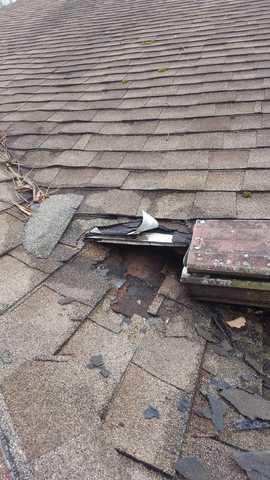Raccoon damaged roof in Wall Township, NJ
Challenge
I was recently dispatched to a home in Wall Township, NJ after the homeowner reported hearing animal noises in the attic. Homeowners often hear scratching noises in the attic since many animals scratch to clear out space for nesting or to bury food. Raccoons are not the only animal that scratches, but because of their size and strength, they are often the loudest. Other common noises with raccoons are made when they are doing “construction work” and enlarging the access site into the attic and also while walking on the roof. Since raccoons are nocturnal, you’ll often hear sounds at night or close to dawn.
The homeowner wasn’t sure whether anything was up there. Sometimes you think that your mind is playing tricks on you and you are just hearing phantom noises or sounds that have nothing to do with a wildlife infestation. This job was a great lesson that, if in doubt, call. It’s far better to know if there is a wildlife infestation overhead so that it can be taken care of.
During my attic inspection, I found large raccoon droppings in the attic. How did I know that these came from a raccoon? Raccoon droppings, at least for a wildlife technician, are distinguishable from other wildlife droppings. First, raccoon poop is fairly large, like dog poop. Considering that raccoons are one of the largest home invading wildlife pests we regularly deal with (reaching up to 20 pounds), the size of their droppings is not surprising. Raccoon poop is dark, tube-shaped, blunt-ended, about 2-3 inches long, and slightly smaller than the diameter of a hot dog. Also, when there is a family of raccoons in the attic, they tend to defecate in shared locations known as latrines. Perhaps, most important for homeowners, raccoon droppings are extremely hazardous. Do not touch these droppings or go near them without proper personal protective equipment. Raccoon poop can contain roundworm eggs — in fact, millions of them if the raccoon is infected. These intestinal parasites easily pass to humans and pets and can cause severe medical issues including loss of muscle control, blindness, and coma.
Solution
In addition to the droppings, I found the raccoons’ access point — a large opening in the roof where the raccoons were able to gain access inside the attic. I secured two large traps on the roof close to the opening. On the roof, I found damaged roofing shingles and pieces of insulation. I explained to the homeowner that after the raccoons are trapped, which would likely be at night or first thing in the morning, I will safely relocate them. Also, for homeowners with attic wildlife infestations often find themselves with a mess after the animals are removed. Cowleys offers cleaning, sanitizing and deodorizing services to make the attic safe once again as well as removal of damaged insulation and installation of top-quality blown-in insulation if desired by the homeowner.


